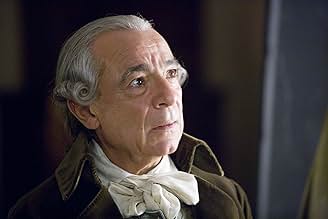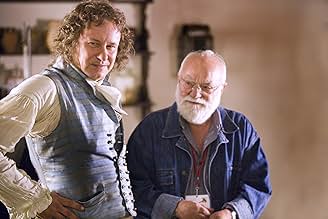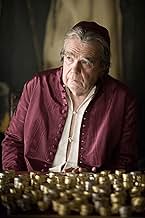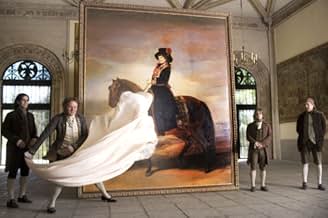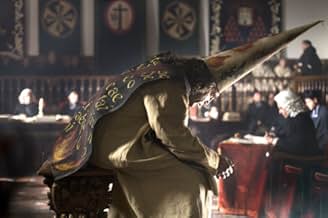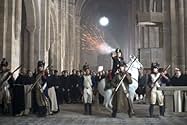Painter Francisco Goya faces a scandal involving his muse, who is labeled a heretic by a monk.Painter Francisco Goya faces a scandal involving his muse, who is labeled a heretic by a monk.Painter Francisco Goya faces a scandal involving his muse, who is labeled a heretic by a monk.
- Director
- Writers
- Stars
- Awards
- 2 wins & 5 nominations total
- Director
- Writers
- All cast & crew
- Production, box office & more at IMDbPro
Featured reviews
The story of the Spanish Inquisition,Napoleanic Wars, a monk and a merchant's daughter and how they affected Francisco Goya.
The movie's plot is complicated,perhaps too complicated, filled with turns and changes its trajectory just when you think it's going one way. You could say that though the story is told from Goya's(Sarsgard) perspective and is primarily advanced by what happens to Ines(Portman) the main character is Lorenzo(Bardem). Its how Lorenzo deals with these situations and how he affects the others that is key. The movie was released a year before No Country For Old Men but Bardem still brings much of the evil and menace he did to Anton Chigurh to this role. However, his role in this film,Lorenzo, is very different and not a deranged killer but more of a scoundrel who carefully picks his tune according to who's in power. Natalie Portman gives a strong performance or performances I should say as she plays two characters. I found this to be distracting as nobody is so identical to their parents but the film is a fictional story.
The film is filled with irony and sardonic moments such as how the Inquistor General sentences Lorenzo to death, then Lorenzo comes to power and orders him to the same fate and ultimately the Inquistor General is restored to power and orders Lorenzo's execution which is carried out successfully this time. Or the ending shot of Lorenzo's dead body being carted off with an insane Ines walking beside carrying an orphaned baby and holding his hand.
The film was written and directed by Milos Forman and not though it isn't of the quality One Flew Over The Cuckoo's Nest or Amadeus it is certainly entertaining and powerful.
The movie's plot is complicated,perhaps too complicated, filled with turns and changes its trajectory just when you think it's going one way. You could say that though the story is told from Goya's(Sarsgard) perspective and is primarily advanced by what happens to Ines(Portman) the main character is Lorenzo(Bardem). Its how Lorenzo deals with these situations and how he affects the others that is key. The movie was released a year before No Country For Old Men but Bardem still brings much of the evil and menace he did to Anton Chigurh to this role. However, his role in this film,Lorenzo, is very different and not a deranged killer but more of a scoundrel who carefully picks his tune according to who's in power. Natalie Portman gives a strong performance or performances I should say as she plays two characters. I found this to be distracting as nobody is so identical to their parents but the film is a fictional story.
The film is filled with irony and sardonic moments such as how the Inquistor General sentences Lorenzo to death, then Lorenzo comes to power and orders him to the same fate and ultimately the Inquistor General is restored to power and orders Lorenzo's execution which is carried out successfully this time. Or the ending shot of Lorenzo's dead body being carted off with an insane Ines walking beside carrying an orphaned baby and holding his hand.
The film was written and directed by Milos Forman and not though it isn't of the quality One Flew Over The Cuckoo's Nest or Amadeus it is certainly entertaining and powerful.
The acting and production values are of the highest order in "Goya's Ghost". Because I don't get around much anymore, I had not seen Ms Portman in a movie until "Ghost", and was very impressed, for like all the roles in this movie, her's was challenging. Javier Bardem is tough to equal in any movie, and as the 'heavy', (another heavy?!) he is outstanding; Stellan Skarsgård has come a long, long ways since "The Ox", and he has had a mixture of roles, some of them pretty thankless. As Goya, he does very well--a great actor. Natalie Portman--as I was a first timer regards seeing her work, I was bowled over--her role requires a terrible transformation, and makeup only goes so far, acting must be the key ingredient. So, along with the outstanding set designs and production values, Forman created another outstanding period piece. By the way, the actress Blanca Portillo who does the Spanish queen has a key small part--and you'll know her best scene when you see it! The story? It is about a wretched time and wretched people in a position of trust who violate that and prey on whomever they can. I think "Ghost" might not be for those who are not really into period pieces, but I am!
I saw it yesterday on film festival. And it was great.
When I was reading the description of the movie, I had some doubts. It seemed it would be yet another film about bad, intolerant catholics and good and democratic atheists. I'm just fed up with that kind of films. But it was not so. In a short - it's a great film with bad description.
What it really is about, is that it doesn't matter what principles one believes in if their life is doesn't match these principles. Both inquisitors and French democrats were capable of same brutality - always, of course, in name of some noble idea - love, freedom, equality... It's not sentimental or pathetic and it doesn't try to tell you what is "the only truth". It simply says that its not principles and ideas that are bad - its people. Characters are very human, with many errors - but, at the same time, each of the characters, even "villains" have moments when you will like them. It is also because the film changes perspective several times, and those who were despots become victims.
Maybe its not the best Forman's film, but it is very good.
When I was reading the description of the movie, I had some doubts. It seemed it would be yet another film about bad, intolerant catholics and good and democratic atheists. I'm just fed up with that kind of films. But it was not so. In a short - it's a great film with bad description.
What it really is about, is that it doesn't matter what principles one believes in if their life is doesn't match these principles. Both inquisitors and French democrats were capable of same brutality - always, of course, in name of some noble idea - love, freedom, equality... It's not sentimental or pathetic and it doesn't try to tell you what is "the only truth". It simply says that its not principles and ideas that are bad - its people. Characters are very human, with many errors - but, at the same time, each of the characters, even "villains" have moments when you will like them. It is also because the film changes perspective several times, and those who were despots become victims.
Maybe its not the best Forman's film, but it is very good.
The film is set in 1792 ,it deals with eclectic people during a convulsed era from Spain history . It starts with the Inquisition and some years later with the encroachment by Napoleon Army and finishes with the French defeat and restoration of the Spanish monarchy with Fernando VII , after the victory by general Wellington (Cayetano M. Irujo) . The painter (1746, born Fuentedetodos and deceased 1828,Burdeos) Francisco de Goya (Stellan Skarsgard) , quintessential Spanish artist , becomes involved with the Spanish Inquisition , when his muse named Ines (director cast Natalie Portman after noticing her likeness to the girl in Goya's painting "Milkmaid of Bordeaux") who painted her like an Angel in the church of Saint Antonio of Florida and he's now portraying , she then is framed as a heretic . His daddy named Thomas Bilbatua (Jose Luis Gomez) ask him help , hoping what his relationship with the monk Lorenzo (Javier Bardem) can achieve the freedom for his daughter . Meanwhile , Goya is dedicated the painting of the portrait the royal family : Carlos IV (Forman cast Randy Quaid as the King of Spain after seeing his work in ¨Elvis¨ by phoning him and saying, "You are a great actor , you must be my King or I must repaint Goya") , Mª Luisa (Blanca Portillo) and children .
The film is a touching drama added with historic elements and formidable performances . The movie creates a canvas upon a turbulent epoch concerning specially with Inquisition . It was created by Pope Sixto IV in 1478 , its creation is supposedly caused for threat by Jewish and Moors becoming Christianism but practically disappeared with the Borbons Kings (Felipe V,Fernando VI and Carlos III) and was definitively abolished by the Court of Cadiz though spontaneously restored by Fernando VII in 1814 . The sentences were executed by means of a public event called ¨auto of faith¨(thus happens on the final) . Near the end, when the king appears in the balcony at the execution scene, some people yell "Vivan Las Cadenas!" (Long live the chains!). This salute was coined in 1814 by Spanish monarchists when Fernando VII was restored to the throne with absolute powers, thus abolishing the Constitution of Cadiz, which was established by Napoleonic authorities.
The flick displays an interesting showing the means are manufactured the famous Goya's engravings : ¨The war disasters¨ , ¨bullfighting¨ and ¨Caprichos¨ . Besides , recreating historical happenings such as ¨Charge of Mamelucos¨ and ¨Execution on mountain of Principe Pio¨. The movie contains a top-notch star-studded cast , as Skarsgard , Portman , Bardem give a sensational interpretations . Scenarios are luxurious and impressive , being designed by the prestigious Patrizia Von Brandenstein , the sets including palaces , rooms , interiors and outdoors are mesmerizing . Lush and brilliant costume design by Ivonne Blake (Oscar for Doctor Zhivago and Nicholas and Alexandra). Colorful cinematography by expert Spanish cameraman , Javier Aguirresarobe , (The others) . The film was lavishly produced by the brothers Saul and Paul Saentz , Forman's usual producers .The motion picture was well directed by the classic Milos Forman , an expert about biographies of notorious characters such as ¨Amadeus¨ , ¨Larry Flynt¨ , ¨Andy Kauffman¨ (Man on the moon) ; besides filming a lot of successes like are ¨Ragtime¨ ,¨Hair¨, ¨Valmont¨ , and of course , his greatest hit ¨Someone flow the Cucko nest¨.
The film is a touching drama added with historic elements and formidable performances . The movie creates a canvas upon a turbulent epoch concerning specially with Inquisition . It was created by Pope Sixto IV in 1478 , its creation is supposedly caused for threat by Jewish and Moors becoming Christianism but practically disappeared with the Borbons Kings (Felipe V,Fernando VI and Carlos III) and was definitively abolished by the Court of Cadiz though spontaneously restored by Fernando VII in 1814 . The sentences were executed by means of a public event called ¨auto of faith¨(thus happens on the final) . Near the end, when the king appears in the balcony at the execution scene, some people yell "Vivan Las Cadenas!" (Long live the chains!). This salute was coined in 1814 by Spanish monarchists when Fernando VII was restored to the throne with absolute powers, thus abolishing the Constitution of Cadiz, which was established by Napoleonic authorities.
The flick displays an interesting showing the means are manufactured the famous Goya's engravings : ¨The war disasters¨ , ¨bullfighting¨ and ¨Caprichos¨ . Besides , recreating historical happenings such as ¨Charge of Mamelucos¨ and ¨Execution on mountain of Principe Pio¨. The movie contains a top-notch star-studded cast , as Skarsgard , Portman , Bardem give a sensational interpretations . Scenarios are luxurious and impressive , being designed by the prestigious Patrizia Von Brandenstein , the sets including palaces , rooms , interiors and outdoors are mesmerizing . Lush and brilliant costume design by Ivonne Blake (Oscar for Doctor Zhivago and Nicholas and Alexandra). Colorful cinematography by expert Spanish cameraman , Javier Aguirresarobe , (The others) . The film was lavishly produced by the brothers Saul and Paul Saentz , Forman's usual producers .The motion picture was well directed by the classic Milos Forman , an expert about biographies of notorious characters such as ¨Amadeus¨ , ¨Larry Flynt¨ , ¨Andy Kauffman¨ (Man on the moon) ; besides filming a lot of successes like are ¨Ragtime¨ ,¨Hair¨, ¨Valmont¨ , and of course , his greatest hit ¨Someone flow the Cucko nest¨.
A film by Milos Forman is always an event. This will probably not remain as one of the best in his career, and was surrounded by a level of controversy, not the least among critics who received it very differently. Yet, it is certainly a film to watch.
The story actually does not have Goya (Stellan Skarsgård) in the center. It is rather the story of a corrupt morality policeman of the 18th century (Javier Bardem) imprisoning a young girl (Natalie Portman) on the unjust suspicion of practicing Judaism in secret. It is the story of a police state built on social injustice relying on pretended moral puritanism in order to save the system. This happens at the price of huge human suffering like the drama in the center of the story, and here is the painter as a witness, living the dilemma of becoming involved as a human or remaining a witness as an artist. We know what path Goya chose.
I was not unhappy neither with the acting, nor with the story line, although it is a little bit too melo-dramatic and too much prone to coincidences. Forman is not so much focused on the drama or better say melo-drama, or even in the historical detail, although he seems to be on familiar ground getting back to the period in 'Amadeus'. What he is busy with seems to be more re-creating some of Goya's paintings and prints and tracing back the origin of inspiration of these masterpieces. In a way the film can be read as justification of the choice Goya made in life.
The story actually does not have Goya (Stellan Skarsgård) in the center. It is rather the story of a corrupt morality policeman of the 18th century (Javier Bardem) imprisoning a young girl (Natalie Portman) on the unjust suspicion of practicing Judaism in secret. It is the story of a police state built on social injustice relying on pretended moral puritanism in order to save the system. This happens at the price of huge human suffering like the drama in the center of the story, and here is the painter as a witness, living the dilemma of becoming involved as a human or remaining a witness as an artist. We know what path Goya chose.
I was not unhappy neither with the acting, nor with the story line, although it is a little bit too melo-dramatic and too much prone to coincidences. Forman is not so much focused on the drama or better say melo-drama, or even in the historical detail, although he seems to be on familiar ground getting back to the period in 'Amadeus'. What he is busy with seems to be more re-creating some of Goya's paintings and prints and tracing back the origin of inspiration of these masterpieces. In a way the film can be read as justification of the choice Goya made in life.
Did you know
- TriviaWhen asked why a film about such a quintessentially Spanish artist was made in English, the director replied "I don't speak Spanish."
- GoofsWhen Goya unveils the unflattering portrait of the queen, she is deeply offended. Actually, queen Maria Louisa liked that portrait so much that she made Goya the first court painter.
- Quotes
[Bonaparte and Lorenzo are looking at paintings of Maria Luisa]
Joseph Bonaparte: I met her once... don't recall her being quite so ugly though. How did she have so many lovers?
Brother Lorenzo: [smiling] She was the Queen, Your Majesty.
- How long is Goya's Ghosts?Powered by Alexa
Details
Box office
- Budget
- $50,000,000 (estimated)
- Gross US & Canada
- $1,000,626
- Opening weekend US & Canada
- $159,671
- Jul 22, 2007
- Gross worldwide
- $9,448,082
- Runtime1 hour 53 minutes
- Color
- Sound mix
- Aspect ratio
- 1.85 : 1
Contribute to this page
Suggest an edit or add missing content



